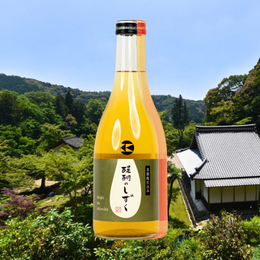
One must imagine that when Dom Perignon's longest serving chef de cave (or Cellar Master, who helms a Champagne house) had announced after a 28 year and 23 vintage stint with arguably the world's most esteemed Champagne house that he was to head to the Japanese countryside to blend Sake, the sheer incredulousness of those who heard it.
Yet, this had been building up for some time now for Richard Geoffroy, the man in question. Just around the turn of the millennium, Richard had been in full flight serving as the chief ambassador of the Champagnes whose cuvee he was responsible for - if he wasn't in the cellars determining the vintage's hotly anticipated cuvee, he was on the road preaching the gospel of the Pope of Champagne. This work would take Richard to Japan on many occasions - over 100 by his own count - and in one particularly memorable event, he had been treated to a fare of Buddhist vegetarian cuisine at the Daitokuji temple in Kyoto, when he was served "the most extraordinary Sake from a jar". This would ignite in him the deepest of fascination with Sake. In a twist of irony, Richard never did find out what the Sake in the jar was nor who made it.


A life in three acts for Richard Geoffroy.
Richard had been born to a family of winegrowers, and yet would instead pursue studies in Medicine, albeit within months upon graduation, determining that he never really did want to be a doctor. He would instead return to Champagne where he was from, and join Moet & Chandon as a winemaker.
To make up for lost time, he would take on harvests anywhere he could, flying from the California to France, Australia and then to Spain and Portugal, completing four vintages a year for six years running. By 1990, he would return home and apprentice directly under Dominique Foulon, Dom Perignon's then chef de cave. By 1996, Richard would take on the mantle.

The next two decades (and 23 vintages) would see Richard spend much of his life embodying the very essence of Dom Perignon. By 2015, having now served the legendary Champagne house for a full two decades, Richard would begin to seriously think about the third act of his life (as he says it, Medicine was a brief first, and Champagne a prolonged second). Having reached the highest echelons of winemaking, he wanted nothing to do with wines, and yet at the same time wanted to be sure that whatever he had set his mind and energy to would be a good and unique match to his skillset - it was certainly not going to be a matter of force-fitting.
"I was ready to take on a new project that would keep me stimulated and inspired. I couldn’t imagine spending my life dedicated to winemaking anymore and I was hoping to move on to something different enough. I wanted to work on something close enough to be wine without it being wine. And voila! Sake is it in so many ways.”

Come 2019, Richard would announce his intention to make Sake.
Yet Sake was on the decline domestically, and visits to numerous breweries was met with rejection, that was until a night out with friend and once-collaborator from Richard's time at LVMH (which owns Dom Perignon), acclaimed Japanese architect Kengo Kuma (famed for designing the Japan National Stadium and the Suntory Museum of Art, both in Tokyo, and also the LVMH Group's Japan HQ, amongst other notable works), who offered to connect Richard with Ryuichiro Masuda, the owner of Toyama Prefecture's highly regarded Masuizumi Brewery. Masuda is the fifth-generation owner of his family's 132 year old Sake brewery, and was himself a big wine lover and collector, and who embraced innovation and new ideas. "We visited Masuda for the weekend, and surprisingly, he was pretty easy to convince. I realised he had a really clear, analytical view of his own industry, which can come across as a little complacent." says Richard.

Ryuichiro Masuda.
Richard didn't want to just make any Sake. Hardly. He had found that in his encounters with Sake, despite how much he loved its drinkability and ease of pairing with food - similarities he saw in Champagne as well - he had found that the Sake enjoyment experience was to his belief still lacking. He believed that Sakes had prioritised aromatics on the nose, and then lacked the ability to follow up in its body, with also too short a finish. For him it was an issue of a lack of balance - balance that he believed could be solved through assemblage. Assemblage is the practice most highly regarded in Champagne houses where the chef de cave works to piece together various components in order to achieve the ideal harmony - and Richard certainly was very good at that. It felt like a match made in heaven. Richard was quoted as saying "If you give me water, I’m pretty sure that I’d start blending water: it’s a compulsive thing. I blend my orange juice at breakfast."

Nevertheless rather than relying on a single batch of Sake which would form the entire Sake expression, Richard had wanted to - like Champagne - piece together various Sakes to create a more balanced cuvee.
“Sake making has been the project of perfecting a single brew for one thousand years or so. Early on, I humbly figured out that one had to push the envelope further to achieve greater balance and complexity; that blending IWA 5 was the one answer, alongside the existing levers of rice polishing and bottle maturation,” says Richard.

Richard also believed that Sake was also too domestically focused and seemed to neglect the world outside of Japan - after all, the demand for Sakes outside of Japan was gaining new heights every single year, and yet it felt like the world at large was underserved (even Sake labels often hardly contain a single line of English text). He wanted to create a Sake that could pair internationally with any other cuisine (instead of solely Japanese cuisine).
Richard who assemble a team with Masuda, who would lend his technical expertise in Sake-making, alongside Kuma, who would design the brewery, Marc Newson (famed Australian industrial designer who worked alongside Jony Ive in shaping Apple's designs) who would set about creating the Sake bottle to be used, with the goal of being a Sake open to the international arena and forgoing the traditional Japanese character labels - ultimately this culminated in a unique matte black bottle without a label and simply emblazoned with the brushstrokes that spell out IWA 5 Sake of Japan, with finally Charles-Antoine Picart (who worked alongside Richard at Dom Perignon as Business Development Director for Asia Pacific) who would serve as CEO of the project.

Acclaimed Japanese architect Kengo Kuma and Australian industrial designer would share in the project, adding to the collaboration their expertise in designing the brewery and the IWA Sake bottle.
The Sake would be named IWA 5 Sake of Japan (or simply IWA Sake), having taken its name from the brewery's location, Shiraiwa, which itself can be translated as "White Rock" (with "Iwa" itself translating as "Rock"), whilst the "5" in the name is a reference to the 5 types of yeasts used in the Sake assemblage, signalling its character as one of many components.

Just under an hour's drive out from the nearest Toyama Station, the brewery sits at the foothills of where the Tateyama mountain ranges meet the coastline to Toyama Bay. It is a reinterpretation of the traditional Japanese gassho-zukuri farmhouse (particularly of those at Gokayama, a UNESCO World Heritage Site). The layout inside is furnished with charred cedar, with the walls covered in traditional washi paper incorporating rice grains from the surrounding rice paddies, and is designed to prioritise horizontality, seeking to meld numerous activities all under a single roof. Its most prominent feature is the central Doma - inspired by the traditional Japanese irori which takes the form of a sunken hearth where communities gather around to socialise. The central Doma is where Richard does the work of assemblage, selecting from over 40 different Sake components to isolate 12-15 Sakes which are then blended in specific proportions in the steel tanks behind the Doma. These steel tanks are even said to resemble the Buddha statues of Kyoto's Sanjusangendou.

On the second level are the wooden Shubo, Motobeya and Koji rooms where the yeast starters are made, and the various varieties of rice are inoculated and fermented, before they are subsequently brewed in the tanks on the first level. Living quarters flank these essential rooms on the second floor providing the team a place to rest during the laborious brewing season where constant monitoring is required - adhering to traditional Japanese Sake-making practices, IWA produces Sakes only once a year during winter.
Working with Masuda, Richard would conclude on the use of Sakes made from 3 primary rice varieties - Yamada Nishiki (the best known and most prestigious of Sake rice, or sakamai), Gohyakumangoku (the second best known sakamai), and Omachi (a fast gaining, more artisanal and ancestral sakamai), brewed with two different yeast starters (the classic Sokujo, and the ancestral Kimoto) and 5 different yeast strains (two of which are wine yeasts), with the rice all polished to a ratio of 35% (that is, 35% of the original rice grain remains after polishing). Explaining the deliberate choices made, Richard would explain, "Yamada Nishiki brings a ‘spine’, a drive to the sake; Omachi brings a lush mouthfeel; and Gohyakumangoku wraps everything together", whilst also adding that he had wanted to keep rice polishing at 35% to qualify the Sake as a Junmai Daiginjo (the highest tier of Sake classification) to bring out maximum aromatics, and yet refuses to go any lower which he deems as being "overpolished".


With its back facing the Tateyama Mountains and the front facing Toyama Bay, the IWA Sake brewery resides amidst fields of rice. A juxtaposition of human intervention and natural wilderness.
The Sake would also uniquely be aged in bottle for over a year before its release, a stylistic choice made by Richard after having observed how well the IWA Sake had aged in bottle. Nevertheless remains yet another major deviation from traditional Sake making. Yet this deliberate choice has led Richard to believe that IWA's Sakes could age well even up to 10 years in bottle.
With the brewery still under construction at the time, the first three expressions of IWA Sake (Assemblage 1, Assemblage 2 and Assemblage 3) was made at Masuizumi Brewery, with the second and third cuvee having to be done from his home in France due to the Covid pandemic. Each Assemblage was kept small, totalling just around 1,000 cases.

And today we're going to get to try Assemblages 3, 4 and 5!
Assemblages 4 and 5 - as well as the new top end IWA Reserves - have since been made at the IWA Sake brewery. Today IWA's Sake-making is led by seasoned Toji Masato Yabuta, who is part of the Tamba Toji Guild, whilst Richard focuses on the assemblage.
IWA Sake has made clear its goal of exporting up to 80% of its production, although it will still keep a sizeable portion to be enjoyed in Japan, as Richard believes validation from locals is essential. Today IWA's Sakes are represented in over 130 Michelin-starred restaurants (of whom 40 hold a 3 Michelin Star), with more than half of them outside the Japanese cuisine - a feat no other producer has achieved in the span of just 18 months.
Today we're over at Praelum, the sommelier's spiritual home when it comes to Singapore's wine scene (and all-round awesome wine bistro), where we got to sit in on an IWA 5 Sake introduction class, and where we got to try Assemblages 3, 4 and 5.
Let's go!
Sake Review: IWA 5 Sake of Japan Assemblage 3
This cuvee was made from Sakes that were in turn made with Yamadanishiki rice from Hyogo and Toyama, Omachi from Okayama, and Gohyakumangoku from Toyama, with also five different yeast strains and an emphasis on the Kimoto starter. There's also a greater proportion of reserve Sakes that has been used in this Assemblage. Rice polishing is kept at 35%, with this being a Junmai Daiginjo. It's also been pasteurised in bottle.

Tasting Notes
Colour: Straw
Aroma: It opens with a distinct muskiness that's backed up by deep waves of umaminess of dashi, bonito broth and soy sauce. It's rich and increasingly honeyed with time, whilst still very much keeping that umaminess, developing into more on sweet soy sauce with a touch of balsamic.
Taste: Medium-bodied here, it's supple and rich, with really good tension and precision. It's well defined in flavour, almost crystalline, yet rounded in texture. It hones in on a deep yet gentle umaminess of soy sauce that's then wrapped around a richer body of mochi like subtle sweetness.
Finish: The umaminess takes a gentler turn here, persisting in its high definition, now outlining the body into the finish. More on soy sauce and bonito broth. It's a seamless and long finish that's then crisp, clean and lightly dry at the end, with lingering aromatics of sweet soy sauce.

My Thoughts
The Assemblage 3 seemed to convey more of a textural quality than necessarily a span and breadth of flavours. It hones in with great precision and definition on the umami character, which it then expresses in this rich yet somehow taut body. It seems rather contrasting and yet this plays completely to what IWA's philosophy is - admittedly I am very surprised by the textural qualities here, which I have yet to encounter in any other Sake I've tried. I found the Assemblage 3 altogether very intentional and deliberate, it feels far too precise to be left to spontaneity, which is all the more impressive considering that this highly defined character is in fact composed of more than 10 Sakes that's been blended together. True to what Richard had sought to achieve, the aromatics here are preserved, whilst the body is given more ampleness, with also a longer and more seamless finish.
Sake Review: IWA 5 Sake of Japan Assemblage 4
This follows largely the same base ingredients as the Assemblage 3 - Yamadanishiki rice from Hyogo and Toyama, Omachi from Okayama, and Gohyakumangoku from Toyama, with also five different yeast strains and an emphasis on the Kimoto starter. Reserve Sakes are also added for this Assemblage. Rice polishing is kept at 35% for this Junmai Daiginjo. It's also been pasteurised in bottle.

Tasting Notes
Colour: Light Straw
Aroma: Incredibly aromatic right away, it's complex, vibrant and very compelling. At the top end, there's lavender florals, juiciness of ripe melons, along with a light tartness of yogurt and a gentle umaminess of soy sauce. With time it gains in honey and a more prominent nuttiness.
Taste: Medium-bodied, it's rich yet with a nice mid-palate crispness. More on honey backed by an umaminess of soy sauce, also giving more on the classic Junmai Daiginjo juiciness of melons and yogurt. There's still that really impressive tension and tautness of the body, eventually progressing along to a savouriness of pepper. The body also features really good concentration to the flavours.
Finish: More on honey soy glaze, with umami soy sauce carrying into the finish. It's got a nice richness and concentration all the way through, and develops into more on hard boiled eggs and bonito. It's a seamless and long finish, clean, with then a lingering gentle yet concentrated and firm, very persistent honeyed umaminess of sweet soy sauce.

My Thoughts
Where the Assemblage 3 seemed to focus on a single note, the Assemblage 4 is much more vibrant and expressive with not just aromatic and flavour intensity, but also in the range of flavours delivered. Assemblage 4 retains some of that umaminess and yet places it alongside more classic Junmai Daiginjo qualities of florals and melons, with also yogurt and peppers. With time it develops more richness and takes on a more honeyed quality. Yet similar to the Assemblage 3, the Assemblage 4 sports the same remarkable tension of its body, concentration of its flavours, and also a long persistent and seamless finish. Again it has a very clear intentionality and deliberateness about it - everything feels curated and clearly pieced together with thoughtfulness. Not a single flavour feels out of place. Here there's less singularity and more radiance. This is incredibly complex and certainly very compelling! This was my favourite of the 3 Assemblages.
PS. It's quite incredible how just a slight change in the proportions of the cuvee has led to such a big shift in flavour.
Sake Review: IWA 5 Sake of Japan Assemblage 5
As with past Assemblages, this follows largely the same base ingredients once again - Yamadanishiki rice from Hyogo and Toyama, Omachi from Okayama, and Gohyakumangoku from Toyama, with also five different yeast strains and an emphasis on the Kimoto starter. Reserve Sakes are also added for this Assemblage. Rice polishing is kept at 35% for this Junmai Daiginjo. It's also been pasteurised in bottle.

Tasting Notes
Colour: Clear
Aroma: Opens supple and fresh, filled in with light tartness of yogurt and ripe juiciness of melons. A crack of black pepper as well. The bouquet here is rounded and plush and with a good depth. There's a light yeastiness, with also an aromatic cellar mustiness that conveys some age. Overall really well integrated.
Taste: Medium-bodied, it's really firm with a good richness and suppleness - the firmness is quite remarkable, giving the body great depth and structure. The body is savoury, with also the same yogurt and melons, really classic Junmai Daiginjo, yet conveyed with depth and a lifted quality. It's elegant with brightness, as well as very lively and energetic.
Finish: It boldens and gains more emphasis here. It's more savoury, with the melon fruitiness more prominent here. A clean and seamless finish, lightly dry, with some lingering yeastiness and savouriness.

My Thoughts
Assemblage 5 feels like a continuation in the direction as we saw in terms of progression from Assemblages 3 and 4, that is, it's more classic Junmai Daiginjo, more of that fruitiness of melons and tartness of yogurt, with a touch of pepper; essentially brighter and more elegant. Here we don't find much (or any) of that umaminess we saw especially in Assemblage 3. Yet, again it shares that similarity in being really precise and well-defined, with the body incredibly firm (here more so than the previous Assemblages) and supple, and with a great depth as well. On the nose, the really lovely aromatics of cellar mustiness was also incredibly remarkable - it seems like the reserve Sakes being added to each subsequent Assemblage is only gaining in intensity and therefore showing itself more so along with each iteration. The finish here is also long and seamless, with the flavours of the body only strengthening. Yet compared to the previous Assemblage 4, this feels again more focused and less so in terms of a range of flavours - somewhat like Assemblage 3 except with a completely different flavour profile.
Now make no mistake - this seems like a classic Junmai Daiginjo on the surface, but it is no standard Junmai Daiginjo. The aromatic depth and firmness of the body, as well as sustained richness of the body through the long and seamless finish is clearly something else altogether.
Kanpai!

@111hotpot







